This is a list of national trees,official.
Deodar-National Tree Of Pakistan
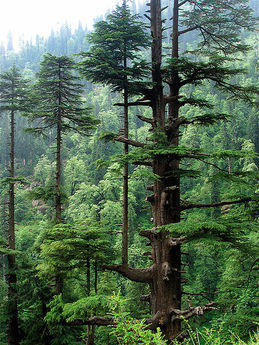
Cedrus deodara (Deodar Cedar, Himalayan Cedar, or Deodar; Hindi, Sanskrit: देवदार devadāru; Chinese: 雪松 xue song) is a species of cedar trees that live in the western Himalayas and in eastern Afghanistan, northern Pakistan, north-central India (Himachal Pradesh, Uttarakhand states), Kashmir, southwesternmost Tibet and western Nepal, and live in places at 1500-3200 m above sea level. It is a large evergreen coniferous tree reaching 40-50 m tall, exceptionally 60 m, with a trunk up to 3m thick. It has a cone-shaped crown with level branches and drooping branchlets.
The leaves are needle-like, mostly 2.5-5 cm long, occasionally up to 7 cm long, very thin (1 mm thick), borne singly on long shoots, and in dense clusters of 20-30 on short shoots; their colours range from bright green to glaucous blue-green in colour. The female cones are barrel-shaped, 7-13 cm long and 5-9 cm broad, and break when up mature (in 12 months) to release the winged seeds. The male cones are 4-6 cm long, and shed their pollen in autumn.
The leaves are needle-like, mostly 2.5-5 cm long, occasionally up to 7 cm long, very thin (1 mm thick), borne singly on long shoots, and in dense clusters of 20-30 on short shoots; their colours range from bright green to glaucous blue-green in colour. The female cones are barrel-shaped, 7-13 cm long and 5-9 cm broad, and break when up mature (in 12 months) to release the winged seeds. The male cones are 4-6 cm long, and shed their pollen in autumn.
Olive-National Tree Of Albania,Greece,Italy,Palestine,Portugal

The Olive (Olea europaea)(Urdu:زیتون), is a species of a small tree in the family Oleaceae, native to the coastal areas of the eastern Mediterranean Basin (The adjoining coastal areas of southeastern Europe, western Asia and northern Africa) as well as northern Iran at the south end of the Caspian Sea. Its fruit, also called the olive, is of major agricultural importance in the Mediterranean region as the source of olive oil. The tree and its fruit give its name to the plant family, which also includes species such as lilacs, jasmine, Forsythia and the true ash trees (Fraxinus). The word derives from Latin "Oliva" which in turn comes from the Greek ἐλαία (elaia) ultimately from Mycenaean Greek e-ra-wa ("elaiva"), attested in Linear B syllabic script.[The word 'oil' in multiple languages ultimately derives from the name of this tree and its fruit.
Lignum vitae-National Tree Of Bahamas
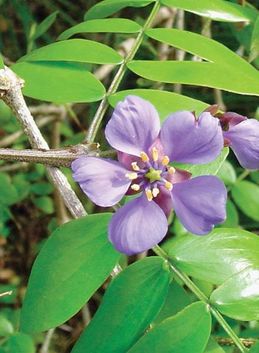
Guaiacum sanctum, commonly known as Holywood or Holywood Lignum-vitae, is a species of flowering plant in the creosote bush family, Zygophyllaceae. It ranges from southern Florida in the United States and the Bahamas south to Central America and the Greater Antilles.It is threatened by habitat loss.
This tree is one of two species which yield the valuable Lignum vitae wood, the other being Guaiacum officinale. This small tree is slow growing, reaching about 7 m (23 ft) in height with a trunk diameter of 50 cm (20 in). The tree is essentially evergreen throughout most of its native range. The leaves are compound, 2.5–3 cm (0.98–1.2 in) in length, and 2 cm (0.79 in) wide. The blue flowers have five petals which yield a yellow fruit with red flesh and black seeds.
This tree is one of two species which yield the valuable Lignum vitae wood, the other being Guaiacum officinale. This small tree is slow growing, reaching about 7 m (23 ft) in height with a trunk diameter of 50 cm (20 in). The tree is essentially evergreen throughout most of its native range. The leaves are compound, 2.5–3 cm (0.98–1.2 in) in length, and 2 cm (0.79 in) wide. The blue flowers have five petals which yield a yellow fruit with red flesh and black seeds.
Mango Tree-National Tree Of Bangladesh
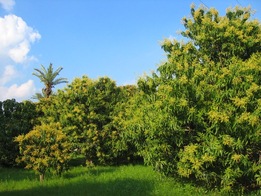
Mangifera indica is a species of mango in the Anacardiaceae family. It is found in the wild in India and cultivated varieties have been introduced to other warm regions of the world.
The species appears to have been domesticated about 4,000 years ago.The species was brought to East Asia around 400-500 BCE from India; next, in the 15th century to the Philippines; and then, in the 16th century to Africa and Brazil by the Portuguese.The species was described for science by Linnaeus in 1753.
Mango is the National Fruit of both India, Philippines and Pakistan and National Tree Of Bangladesh. It finds mention in the songs of 4th century CE Sanskrit poet, Kalidasa, prior to it is believed to have been tasted by Alexander (3rd century BCE) and Chinese pilgrim, Hieun Tsang (7th century CE). Later in 16th century Mughal Emperor, Akbar planted 100,000 mango trees in Darbhanga, Bihar at a place now known as Lakhi Bagh.
The species appears to have been domesticated about 4,000 years ago.The species was brought to East Asia around 400-500 BCE from India; next, in the 15th century to the Philippines; and then, in the 16th century to Africa and Brazil by the Portuguese.The species was described for science by Linnaeus in 1753.
Mango is the National Fruit of both India, Philippines and Pakistan and National Tree Of Bangladesh. It finds mention in the songs of 4th century CE Sanskrit poet, Kalidasa, prior to it is believed to have been tasted by Alexander (3rd century BCE) and Chinese pilgrim, Hieun Tsang (7th century CE). Later in 16th century Mughal Emperor, Akbar planted 100,000 mango trees in Darbhanga, Bihar at a place now known as Lakhi Bagh.
Golden Trumpet Tree-National Tree Of Brazil
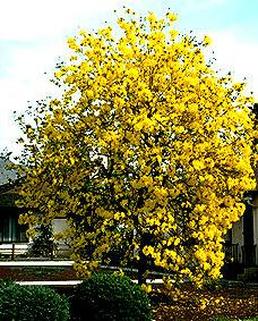
Abebuia alba also Golden Trumpet Tree, is a tree native to Cerrado vegetation in Brazil. This plant is found in the following states of Brazil: Bahia, Espírito Santo, Goiás, Mato Grosso do Sul, Minas Gerais, Paraná, Rio de Janeiro, Rio Grande do Sul, Santa Catarina, and São Paulo.It is used as a urban tree, and it is also used as a medicinal plant.
Well-known and popular, the tree and its flower belong to the National Plants of Brazil.
Well-known and popular, the tree and its flower belong to the National Plants of Brazil.
Cuban Royal Palm-National Tree Of Cuba
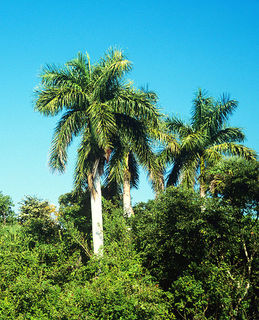
Roystonea regia, commonly known as the Cuban royal palm, Florida royal palm, or simply the royal palm is a species of palm which is native to southern Florida, Mexico and parts of Central America and the northern Caribbean. It ranged into central Florida in the eighteenth century but in modern times it is only known from tropical parts of South Florida. A large and attractive palm, it has been planted throughout the tropics and subtropics as an ornamental tree. Although it is sometimes called R. elata, the name conserved name R. regia now the correct name for the species. Populations in Cuba and Florida were long seen as separate species, but are now considered to belong to a single species.
Best known as an ornamental, R. regia is also used as a source of thatch, construction timber, and as a medicinal plant. The fruit is eaten by birds and bats (Which disperse the seeds) and fed to livestock. Its flowers are visited by birds and bats, and it serves as a roosting site and food source for a variety of animals. Roystonea regia is the national tree of Cuba,and has religious role both in Santería and Christianity, where it is used in Palm Sunday observances.
Best known as an ornamental, R. regia is also used as a source of thatch, construction timber, and as a medicinal plant. The fruit is eaten by birds and bats (Which disperse the seeds) and fed to livestock. Its flowers are visited by birds and bats, and it serves as a roosting site and food source for a variety of animals. Roystonea regia is the national tree of Cuba,and has religious role both in Santería and Christianity, where it is used in Palm Sunday observances.
Monkey-puzzle Tree-National Tree Of Chile
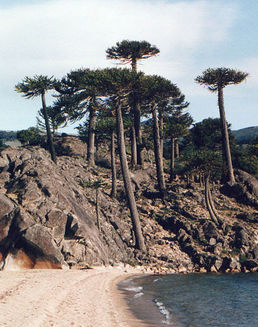
Araucaria araucana (Popularly called The Monkey-puzzle Tree) is an evergreen tree growing to 40 metres (130 ft) tall with a 2 metres (7 ft) trunk diameter. The tree is native to south-central Chile and west central Argentina. Araucaria araucana is the hardiest species in the conifer genus Araucaria. Because of the species's great age it is sometimes described as a living fossil.
The leaves are thick, tough and scale-like, triangular, 3–4 cm long, 1–3 cm broad at the base, and with sharp edges and tip. They persist for 10–15 years or more, so cover most of the tree except for the older branches.
It is usually dioecious, with the male and female cones on separate trees, though occasional individuals bear cones of both sexes. The male (pollen) cones are oblong and cucumber-shaped, 4 cm long at first, expanding to 8–12 cm long by 5–6 cm broad at pollen release. The tree is wind pollinated. The female (seed) cones, which mature in autumn about 18 months after pollination, are globose, large, 12–20 cm diameter, and hold about 200 seeds. The cones disintegrate at maturity to release the 3–4 cm long nut-like seeds, which are then dispersed by jays and squirrels.
The leaves are thick, tough and scale-like, triangular, 3–4 cm long, 1–3 cm broad at the base, and with sharp edges and tip. They persist for 10–15 years or more, so cover most of the tree except for the older branches.
It is usually dioecious, with the male and female cones on separate trees, though occasional individuals bear cones of both sexes. The male (pollen) cones are oblong and cucumber-shaped, 4 cm long at first, expanding to 8–12 cm long by 5–6 cm broad at pollen release. The tree is wind pollinated. The female (seed) cones, which mature in autumn about 18 months after pollination, are globose, large, 12–20 cm diameter, and hold about 200 seeds. The cones disintegrate at maturity to release the 3–4 cm long nut-like seeds, which are then dispersed by jays and squirrels.
Wax Palm Tree-National Tree Of Colombia
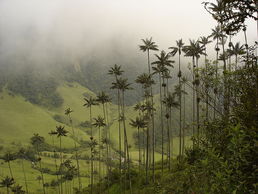
Ceroxylon quindiuense (Palma de cera del quindio, Wax palm tree), is a palm native to the Andean high altitude valley of Cocora in the department of Quindío, northwest Colombia.
The wax palm grows up to 50 m (Rarely to 60 m) tall in good growing conditions and is not only the tallest palm but the tallest monocot in the world. The leaves are dark green and grayish, with a petiole up to 2 m long. The trunk is cylindrical, smooth, light colored and covered with wax, When the leaves die they fall and this forms a dark ring around the trunk. The palm is recognized as the national tree of Colombia, and since the implementation of the law 61 of 1985 is legally a protected species. Ceroxylon quindiuense has an extremely slow growth and can live up to a hundred years. It was observed by Alexander von Humboldt, for the first time, in 1801.
The wax palm grows up to 50 m (Rarely to 60 m) tall in good growing conditions and is not only the tallest palm but the tallest monocot in the world. The leaves are dark green and grayish, with a petiole up to 2 m long. The trunk is cylindrical, smooth, light colored and covered with wax, When the leaves die they fall and this forms a dark ring around the trunk. The palm is recognized as the national tree of Colombia, and since the implementation of the law 61 of 1985 is legally a protected species. Ceroxylon quindiuense has an extremely slow growth and can live up to a hundred years. It was observed by Alexander von Humboldt, for the first time, in 1801.
Oak Tree-National Tree Of Germany,Moldova,Romania,Serbia,U.S.A,Second National Tree Of Italy
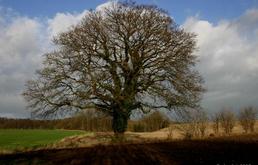
The Oak Tree (Quercus) is a kind of hardwood forest tree. Oak trees come in many different kinds of species, but all of them have large seeds called acorns. There are over 300 varieties over oak trees.
Oak trees grow all over many parts of Europe and North America. Many people who own wooded land in these parts of the world are proud of their oak trees. Oak is a climax vegetation in much of the Northern Hemisphere. What that means is, left untouched by humans, it would be the dominant tree. Much of England was covered by oak forests before modern farming took over the land. The last extensive oak woodlands were cut down to build ships for the Royal Navy in the 18th century.
Some kinds of oak wood are very hard. A lot of furniture was made from oak wood, but the wood is now scarce and expensive. Much cheaper are softwoods like pine.
Most oak trees lose all of their leaves in autumn. A special kind of oak tree, the "live oak", grows in the American South. It is called the "live oak" because it keeps many of its leaves over the winter.
Oak trees can live up to 1000 years.
Oak trees grow all over many parts of Europe and North America. Many people who own wooded land in these parts of the world are proud of their oak trees. Oak is a climax vegetation in much of the Northern Hemisphere. What that means is, left untouched by humans, it would be the dominant tree. Much of England was covered by oak forests before modern farming took over the land. The last extensive oak woodlands were cut down to build ships for the Royal Navy in the 18th century.
Some kinds of oak wood are very hard. A lot of furniture was made from oak wood, but the wood is now scarce and expensive. Much cheaper are softwoods like pine.
Most oak trees lose all of their leaves in autumn. A special kind of oak tree, the "live oak", grows in the American South. It is called the "live oak" because it keeps many of its leaves over the winter.
Oak trees can live up to 1000 years.
Indian Banyan-National Tree Of India
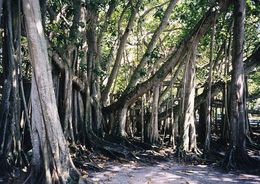
The Indian banyan (Urdu:برگد) (Ficus benghalensis) is a large and extensive growing tree of the Indian subcontinent. Ficus benghalensis produces propagating roots which grow downwards as aerial roots. Once these roots reach the ground, they grow into woody trunks that can become indistinguishable from the main trunk.
Other names are also known as 'Bengal fig', 'Indian fig', also borh, wad, Peral. Sanskrit names include nyagrodha.
Other names are also known as 'Bengal fig', 'Indian fig', also borh, wad, Peral. Sanskrit names include nyagrodha.
Cherry Blossom-National Tree Of Japan

A cherry blossom is the flower of the cherry trees known as Sakura (桜 or 櫻; さくら?). In English, "Sakura" refers to the Japanese flowering cherry, Prunus serrulata.Cherry fruit (桜んぼ sakuranbo) comes from another species of tree.
Cherry blossoms are indigenous to many East Asian states including Japan, Korea, and China. Japan has a wide variety of cherry blossoms (Sakura): well over 200 cultivars can be found there.
Cherry blossoms are indigenous to many East Asian states including Japan, Korea, and China. Japan has a wide variety of cherry blossoms (Sakura): well over 200 cultivars can be found there.
Lebanon Cedar-National Tree Of Lebanon
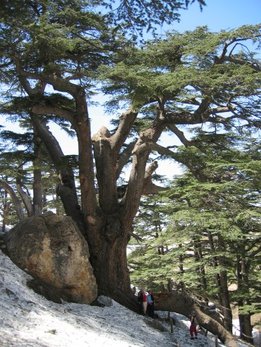
Cedrus libani is a species of cedar native to the mountains of the Mediterranean region.There are two distinct types that are considered to be different subspecies or varieties. Lebanon cedar or Cedar of Lebanon (Cedrus libani subsp. libani or var. libani) grows in Lebanon, western Syria and south central Turkey, and the Turkish cedar or Taurus cedar (Cedrus libani subsp. stenocoma or var. stenocoma) grows in southwest Turkey.
The Lebanon Cedar is an evergreen coniferous tree growing up to 40 m (130 ft) tall, with a trunk up to 2.5 m (8 ft 2 in) in diameter. The crown is conic when young, becoming broadly tabular with age with fairly level branches.
The shoots are dimorphic, with long shoots and short shoots. The leaves are needle-like, spaced out on the long shoots, and in clusters of 15-45 on the short shoots; they are 5–30 mm (1⁄4–1 3⁄16 in) in length, quadrangular in cross-section, and vary from green to glaucous blue-green with stomatal bands on all four sides. The seed cones are produced often every second year, and mature in 12 months from pollination; mature cones in late autumn are 8–12 cm (3–4 3⁄4 in) long and 4–6 cm (1 1⁄2–2 3⁄8 in) wide.
The Lebanon Cedar is an evergreen coniferous tree growing up to 40 m (130 ft) tall, with a trunk up to 2.5 m (8 ft 2 in) in diameter. The crown is conic when young, becoming broadly tabular with age with fairly level branches.
The shoots are dimorphic, with long shoots and short shoots. The leaves are needle-like, spaced out on the long shoots, and in clusters of 15-45 on the short shoots; they are 5–30 mm (1⁄4–1 3⁄16 in) in length, quadrangular in cross-section, and vary from green to glaucous blue-green with stomatal bands on all four sides. The seed cones are produced often every second year, and mature in 12 months from pollination; mature cones in late autumn are 8–12 cm (3–4 3⁄4 in) long and 4–6 cm (1 1⁄2–2 3⁄8 in) wide.
Mesua Ferrea-National Tree Of Sri Lanka
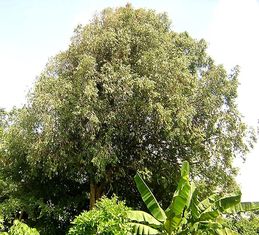
Mesua ferrea [Ceylon ironwood, Indian rose chestnut, Cobra's saffron or locally, Penaga Lilin,Na (Sinhalese) or Nahar/Nahor, Sanskrit Nāga नाग, नागर, नागकेशर)] is a species in the family Calophyllaceae. The plant is named after the heaviness of its timber and cultivated in tropical climates for its form, foliage, and fragrant flowers. It is native to tropical Sri Lanka but also cultivated in Assam, southern Nepal, Indochina, and the Malay Peninsula.
It is a tall tree reaching up to 100 feet tall, often buttressed at the base with a trunk up to 2 meters in diameter. It is common in wet zone at Sri Lanka up to 1500 meters. It has simple, narrow, oblong, dark green leaves 7–15 cm long, with a whitish underside; the emerging young leaves are red to yellowish pink and drooping. The flowers are 4–7.5 cm diameter, with four white petals and a center of numerous yellow stamens.
It is a tall tree reaching up to 100 feet tall, often buttressed at the base with a trunk up to 2 meters in diameter. It is common in wet zone at Sri Lanka up to 1500 meters. It has simple, narrow, oblong, dark green leaves 7–15 cm long, with a whitish underside; the emerging young leaves are red to yellowish pink and drooping. The flowers are 4–7.5 cm diameter, with four white petals and a center of numerous yellow stamens.
Coconut Palm-National Tree Of Maldives

The Coconut palm is a type of palm tree. It is a part of the Family Arecaceae (palm family). It is a large palm, growing to 30 m tall. It has leaves that are 4–6 m long. The term coconut refers to the fruit of the coconut palm.
A coconut is a large nut. Coconuts grow in tropical countries. The flesh of a coconut is white and can be eaten raw or used in cooking. It is used in many of the foods we eat for flavour, and are native in tropical areas Especially in India.
There are many coconut palms in the coastal belt of India and Bangladesh. People of this area use coconut milk in cooking. Women use coconut oil as hair oil for hair. The Coconut's shell is relatively hard, but can be broken.
A coconut is a large nut. Coconuts grow in tropical countries. The flesh of a coconut is white and can be eaten raw or used in cooking. It is used in many of the foods we eat for flavour, and are native in tropical areas Especially in India.
There are many coconut palms in the coastal belt of India and Bangladesh. People of this area use coconut milk in cooking. Women use coconut oil as hair oil for hair. The Coconut's shell is relatively hard, but can be broken.
Pine-National Tree Of South Korea,Ukraine

Pines (Urdu:صنوبر) are a family of conifers. It includes many well-known conifers such as cedars, firs, hemlocks, larches, pines and spruces. It is the largest living conifer family with between 220–250 species in 11 genera, and the second largest in geographical range, found in most of the Northern Hemisphere. Major centres of diversity are found in the mountains of southwest China, Mexico, central Japan and California.
Pine is a genus in the Pinaceae family of the conifer division (Pinophyta). The wood that comes from it is also called pine. Pine is a softwood, with many uses. It is often used in furniture. This is because of its natural durability, and it is less expensive than hardwoods. All softwoods take up to 10–20 years to grow, which quicker than deciduous (hardwood) trees which take up to 100 years to grow.
Pines are found in almost the entire Northern Hemisphere. In North America, they are found from the southern part of Arctic to Nicaragua and Hispaniola. In Europe, they are found from Portugal and Scotland to Russia and in Asia, they are found from Russia to Japan and Philippines. They are also found in the Himalayas and some northern parts of Africa. They are also found in the North of Majorca (Mallorca) on the rugged mountains. Pines are trees that are wideley spread around the world.
Pine is a genus in the Pinaceae family of the conifer division (Pinophyta). The wood that comes from it is also called pine. Pine is a softwood, with many uses. It is often used in furniture. This is because of its natural durability, and it is less expensive than hardwoods. All softwoods take up to 10–20 years to grow, which quicker than deciduous (hardwood) trees which take up to 100 years to grow.
Pines are found in almost the entire Northern Hemisphere. In North America, they are found from the southern part of Arctic to Nicaragua and Hispaniola. In Europe, they are found from Portugal and Scotland to Russia and in Asia, they are found from Russia to Japan and Philippines. They are also found in the Himalayas and some northern parts of Africa. They are also found in the North of Majorca (Mallorca) on the rugged mountains. Pines are trees that are wideley spread around the world.
The Date Palm-National Tree Of Saudi Arabia

The Date Palm (Phoenix dactylifera) is a palm in the genus Phoenix, cultivated for its edible sweet fruit. Although its place of origin is unknown because of long cultivation, it probably originated from lands around the Persian Gulf.It is a medium-sized plant, 15–25 m tall, growing singly or forming a clump with several stems from a single root system. The leaves are 3–5 m long, with spines on the petiole, and pinnate, with about 150 leaflets; the leaflets are 30 cm long and 2 cm wide. The full span of the crown ranges from 6 to 10 m.
Dates have been a staple food of the Middle East for thousands of years. They are believed to have originated around the Persian Gulf, and have been cultivated since ancient times from Mesopotamia to prehistoric Egypt, possibly as early as 4000 BCE. The Ancient Egyptians used the fruits to be made into date wine, and ate them at harvest. There is archaeological evidence of date cultivation in eastern Arabia in 6000 BCE. (Alvarez-Mon 2006).
In later times, Arabs spread dates around South and South West Asia, northern Africa, and Spain and Italy. Dates were introduced into Mexico and California by the Spaniards by 1765, around Mission San Ignacio.
Dates have been a staple food of the Middle East for thousands of years. They are believed to have originated around the Persian Gulf, and have been cultivated since ancient times from Mesopotamia to prehistoric Egypt, possibly as early as 4000 BCE. The Ancient Egyptians used the fruits to be made into date wine, and ate them at harvest. There is archaeological evidence of date cultivation in eastern Arabia in 6000 BCE. (Alvarez-Mon 2006).
In later times, Arabs spread dates around South and South West Asia, northern Africa, and Spain and Italy. Dates were introduced into Mexico and California by the Spaniards by 1765, around Mission San Ignacio.
Royal Oak-National Tree Of United Kingdom
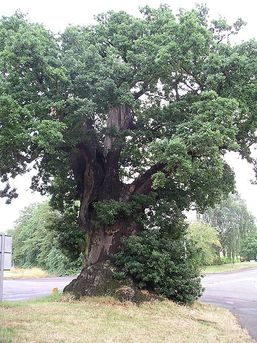
Quercus robur (Sometimes considered Q. pedunculata or "Q. robur") is commonly known as the Pedunculate Oak or Royal Oak or English oak. It is native to most of Europe, and to Anatolia to the Caucasus, and also to parts of North Africa.
Q. robur is a large deciduous tree 25–35 m tall (exceptionally to 50 m), with lobed and nearly sessile (very short-stalked) leaves 7–14 cm long. Flowering takes place in mid spring, and their fruit, called acorns, ripen by the following autumn. The acorns are 2–2.5 cm long, pedunculate (having a peduncle or acorn-stalk, 3–7 cm long) with one to four acorns on each peduncle.
It is a long-lived tree, with a large widespreading crown of rugged branches. While it may naturally live to an age of a few centuries, many of the oldest trees are pollarded or coppiced, both pruning techniques that extend the tree's potential lifespan, if not its health.
Q. robur is a large deciduous tree 25–35 m tall (exceptionally to 50 m), with lobed and nearly sessile (very short-stalked) leaves 7–14 cm long. Flowering takes place in mid spring, and their fruit, called acorns, ripen by the following autumn. The acorns are 2–2.5 cm long, pedunculate (having a peduncle or acorn-stalk, 3–7 cm long) with one to four acorns on each peduncle.
It is a long-lived tree, with a large widespreading crown of rugged branches. While it may naturally live to an age of a few centuries, many of the oldest trees are pollarded or coppiced, both pruning techniques that extend the tree's potential lifespan, if not its health.
Araguaney-National Tree Of Venezuela
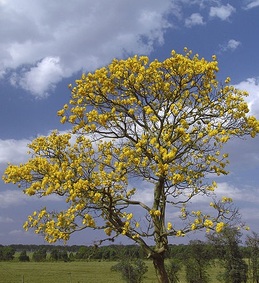
Tabebuia chrysantha (Araguaney or Yellow Ipe), known as cañaguate in northern Colombia, as tajibo in Bolivia, and as ipê-amarelo in Brazil, is a native tree of the intertropical broadleaf deciduous forests of South America above the Tropic of Capricorn. On May 29, 1948, Tabebuia chrysantha was declared National Tree of Venezuela since being an emblematic native species of extraordinary beauty. Its deep yellow resembles the one on the Venezuelan flag. It is one of about 100 species of Tabebuia.
It is a rustic decidious tree that defies hard, dry or poor soils. Therefore its roots require well drained terrain. Its height ranges 6 to 12m. Leaves are opposite and petiolate, elliptic and lanceolate, with pinnate venation. Flowers are large, tubular shaped, with broadening corolla of deep yellow colour, about 2 inches long; they come out (February to April) before the tree has grown back any leaves. The fruit consists of dehiscent capsule often matured by the end of dry season. It is a slow growing, but long lasting, tree.
As said, flowering and fruiting take place in dry season, from February to April, this way the seeds can take advantage of early rains. If raining season is delayed, the araguaney may flower and fruit, mildly, a second time. It is a highly efficient moisture manager. As happens with mango, the araguaney biological functions requiring most water take place precisely during dry season.
It is a rustic decidious tree that defies hard, dry or poor soils. Therefore its roots require well drained terrain. Its height ranges 6 to 12m. Leaves are opposite and petiolate, elliptic and lanceolate, with pinnate venation. Flowers are large, tubular shaped, with broadening corolla of deep yellow colour, about 2 inches long; they come out (February to April) before the tree has grown back any leaves. The fruit consists of dehiscent capsule often matured by the end of dry season. It is a slow growing, but long lasting, tree.
As said, flowering and fruiting take place in dry season, from February to April, this way the seeds can take advantage of early rains. If raining season is delayed, the araguaney may flower and fruit, mildly, a second time. It is a highly efficient moisture manager. As happens with mango, the araguaney biological functions requiring most water take place precisely during dry season.

